Of the few devices from the brand Aune that have endured our tortures and various operations led with a screwdriver, we have some fond memories, as much regarding their serious and trustworthy appearance, as for their advanced electronics and great sonic performances. We bestowed a Qobuzism to the S16 DAC and to the B1 headphone amplifier, and we were taken with the refinement of the X1s DAC.
We can say that the S6 appears as a successor of the S16, of which he takes more or less all the functionalities and updates with the competition by offering a symmetrical headphone output in addition to the standard one, its headphone amplifier delivering otherwise an impressive dose of power. Therefore, we invite you to discover this Aune S6 DAC through its testing ground.
||About the Aune S6 DAC|| |Type:|Home digital-to-analog converter with a symmetrical preamplifier and a symmetrical and standard headphone amplifier| |Function:|Transforms digital audio data into analog signals and amplifies them to drive headphones or to be linked to a power amplifier| |Digital inputs:|USB B, S/PDIF (1 x coaxial, 1 x optical)
AES/EBU on a three-pin XLR plug| |Analog inputs:|None| |Digital-to-analog converter:|Asahi Kasei AK4495S (32-Bit/384 kHz,
DSD64 and 128)| |Audio outputs:|Headphone Out on 6.35 mm Jack, four-pin XLR in symmetrical mode, preamplifier on RCA in standard mode and on three-pin XLR plugs in symmetrical mode| |Frequency response:|20 Hz - 20 kHz| |Headphone max power:|280 mW/32 Ω (Jack output)
1000 mW/32 Ω (symmetrical output)| |Dimensions (L x H x P) :|288 x 63 x 211| |Weight:|6.61 lbs (3 kg)| |Design/Manufacturing:|China/China| |R.R.P.:|About 550 euros| |Contact:|Audiophonics|
Presentation
The Aune S6 DAC with headphone amplifier, whose full anodized aluminum box has slightly curved lines, displays a design both sober and sophisticated.
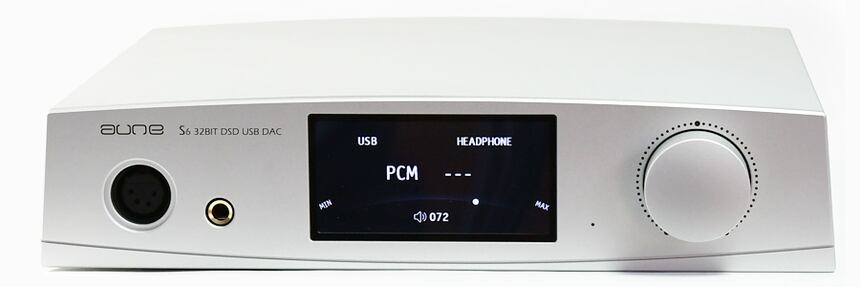
You’ll find on the left part of the facade a four-pin XLR plug allowing you to plug a pair of headphones or earbuds running in symmetrical mode, next to a 6.35 mm Jack for standard headphones.
A big and beautiful display occupies the center of the facade. It indicates the selected input and output, signal type and sampling frequency, while a dot positions itself on a curved scale located on top of a small speaker-shaped pictogram and of the numerical value of the volume (ranging from 000 to 100).
The big scroll wheel on the right allows you to turn the volume up or down; with a small press, to change the digital input, and, with two successive small presses, to go from the headphone out to the line out and, when you press it for more than five seconds, to power the device on or off.
In the back, you’ll find the mains power input, the four digital inputs—USB B, coaxial and optical S/PDIF, and AES/EBU on a female three-pin XLR plug—as well as variable audio outputs, in standard mode on RCA, and in symmetrical mode on XLR plugs.
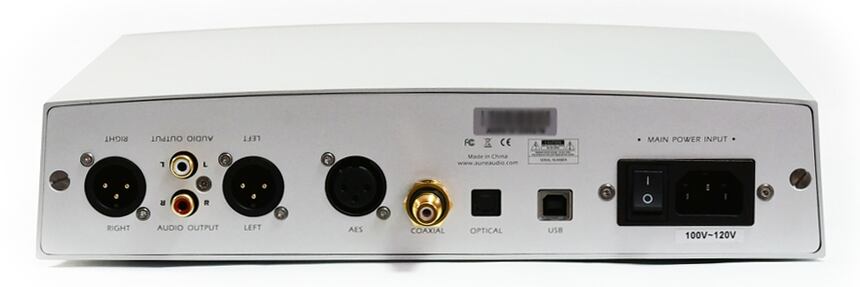
Manufacturing
A single card hosts nearly all the electronics of the Aune S6 DAC, with only the global management and the display controls being located on another circuit board mounted along the facade and which hosts the STMicroelectronics STM32F103 microcontroller.
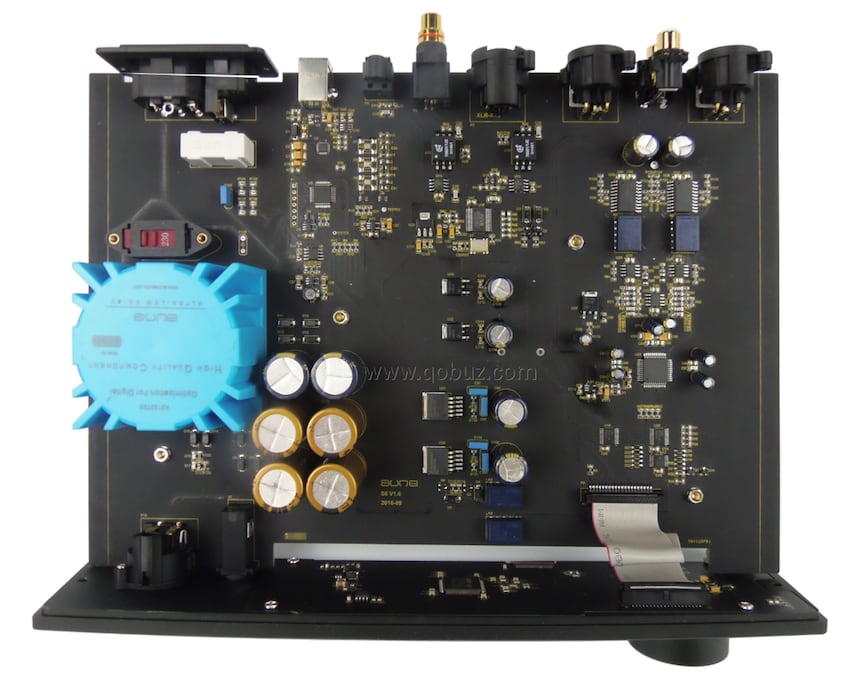
The power supply uses an encapsulated transformer preceded by a mains voltage selector. The filtering of the rectified voltages is handled by four Nichicon 4700 μF/35V and two Panasonic 2200 μF/35V electrochemical capacitors.
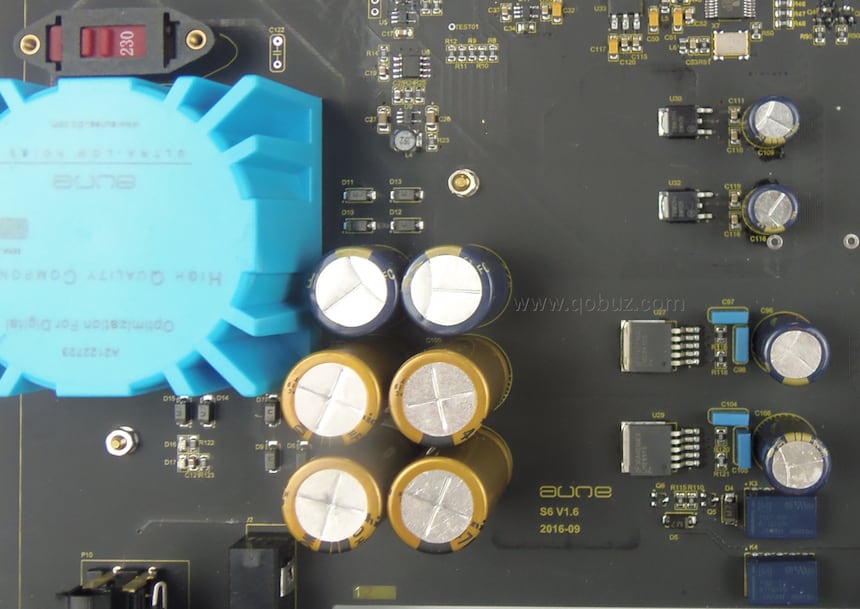
You can also see two National Semiconductor LM2941CS and LM2991S adjustable regulators stabilizing the symmetrical voltages required to the operational amplifiers from the analog part and to the headphone amplifiers. Two 78M05 +5V regulators stabilize the voltages required by the circuits transmitting the digital audio signals and by the management electronics.
The USB input is made up of a Microchip USB3318 interface and of a XMOS 8U6C5 processor with its three oscillators, one for the internal clock, and the two others for the synchronization with the 44 kHz signals and their multiples, and with the 48 kHz signals and their multiples.
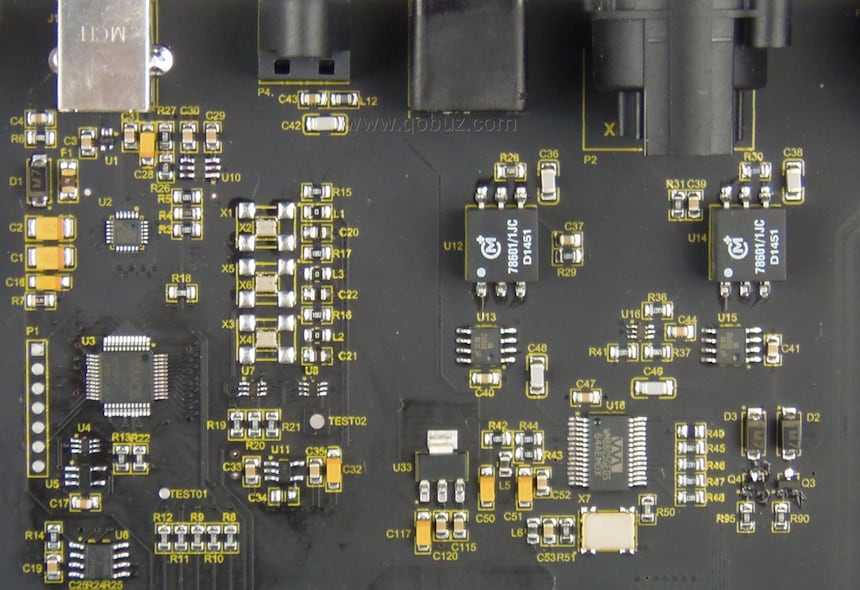
A Wolfson WM8805 circuit interfaces and commutes the three S/PDIF inputs and extracts from them the I2S bus. The switching of the I2S buses from the USB input or the S/PDIF interface towards the digital-to-analog conversion chip is handled by Texas Instruments SN74LVC2244A chips, this conversion chip being the high-performing Asahi Kasei AK4495SEQ compatible with PCM signals up to 32-Bit/768 kHz, DSD64 and DSD128.
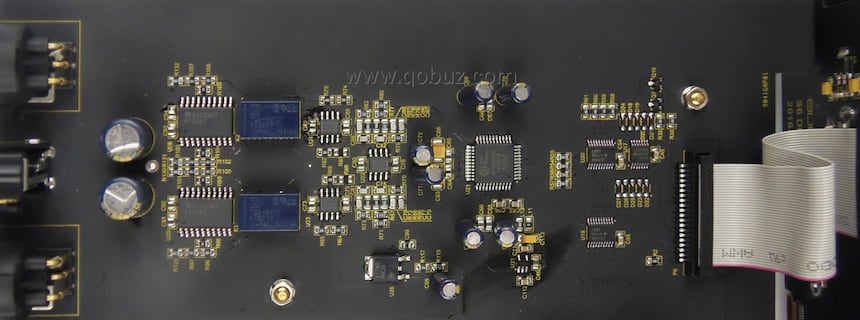
The signals coming from the AK4495SEQ converter are then cleaned by an active filter using a Texas Instruments N5532 dual low-noise operational amplifier. Two other N5532 take care of building the positive and negative parts of the symmetrical signals that will be available on the XLR output plugs, or on the two Texas Instruments TPA6120A2 stereo headphone amplifiers.
In both cases, the positive part of the signals will be used on the RCA connectors to connect an amplifier in asymmetrical mode, or on the 6.35 mm Jack to plug a standard pair of headphones. The volume is controlled by an optical encoder whose impulsions are handled by the microcontroller that acts on the attenuator integrated to the AK4495SEQ.
Sound
For our listening sessions, we’ll start with one of our favorites these days, Dvorak’s Symphony No. 6 performed by the London Philharmonic Orchestra conducted by Yannick Nézet-Séguin, that we’ll stream from Qobuz Desktop on PC.
The Aune DAC, linked from its RCA connectors to our Sony UDA-1 amplifier driving our Triangle Antal Anniversary speakers, has offered a really beautiful reproduction of this piece, by displaying a rather good tonal balance, with trebles that are however somewhat softened, which doesn’t prevent the colors of Dvorak’s rich orchestration to express their nuances and the different music stands to be put in perspective, whether pianissimo or mezzo-forte. Even if it’s very beautiful, we tend to find this restitution a bit tame.
Let’s not remain in doubt and let’s listen to Vivaldi’s Vespri per l'Assunzione di Maria Vergine performed by the Concerto Italiano conducted by Rinaldo Alessandrini. Indeed, we’ve lost a bit on the swift chord attacks on this interpretation, but it’s still being restituted beautifully with its great timber richness and it almost becomes even more relaxing!
It’s a somewhat softened version of the title How To Fall In Love from the Bee Gees’ album Size Isn't Everything that offers us the Aune S6 DAC, with the bass doing its job efficiently while supporting a restitution where Barry Gibb’s falsetto voice shows itself to be less biting, but the eminently singing character of this song indubitably gains a lot. As with Vivaldi, the guitar chords opening the superb title For Whom The Bell Tolls are a bit softened, but the rest of the song is reproduced with scale, warmth and great beauty.
Listening to the same titles with our Oppo PM-3 headphones plugged into the 6.35 mm Jack standard output, our sonic feelings were the same. The TPA6120A2 amplifiers don’t have any sound signature, and deliver, in normal (asymmetrical) amplification, a power that was more than enough for comfortable listening (55 out of 100), and that didn’t pull any punches in the solid bass department.
To conclude, this Aune S6 DAC is a seriously designed and built device, made to last, especially since the conversion chip included is up-to-date. Moreover, it offers a beautiful sound restitution which, even if it’s a bit tame, absolutely doesn’t prevent it from providing a lot of musical pleasure in its own way.
We would like to thank

